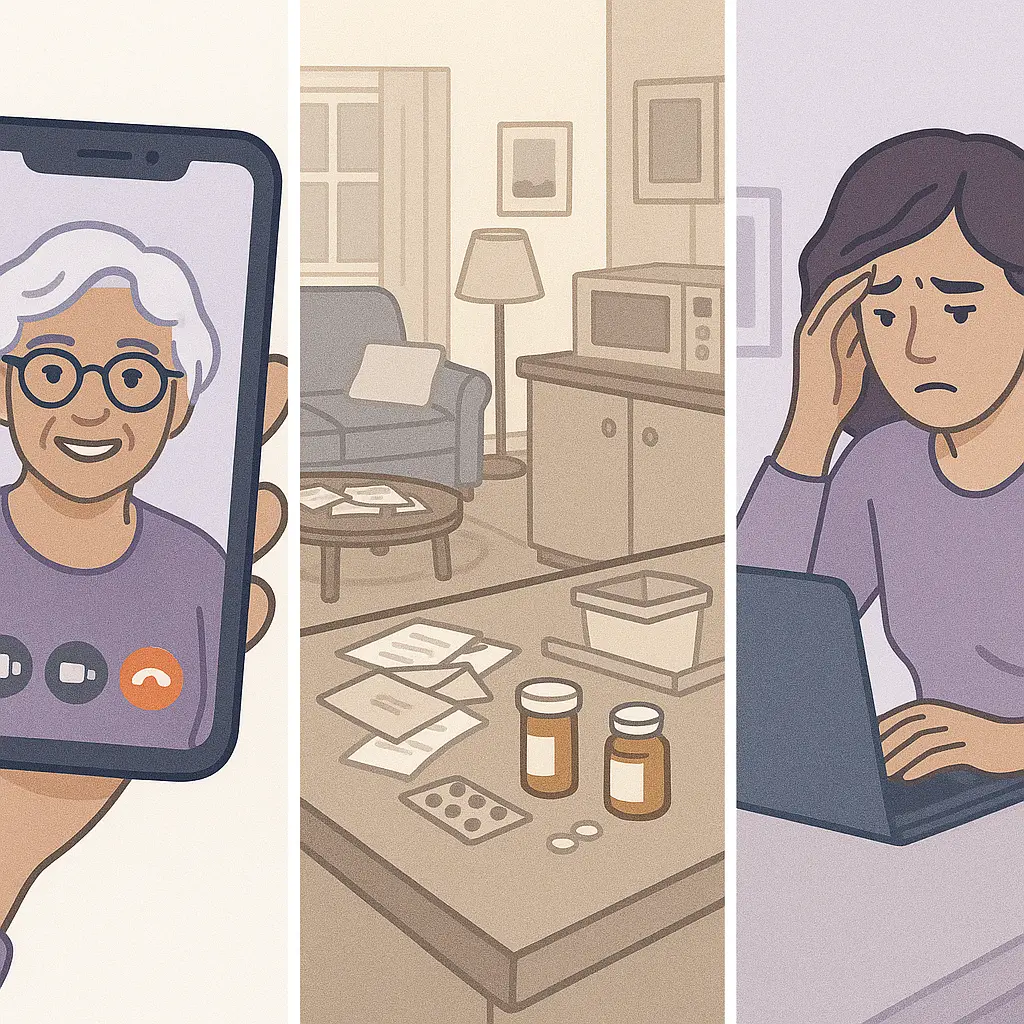When “Mom’s Fine” Becomes a Family Crisis: The Hidden Truth About Aging in Place
The text messages flew back and forth between three siblings on a Tuesday afternoon:
- Sarah: “I stopped by Mom’s today. The house is a mess, and there’s expired food in the fridge. I’m really worried.”
- David: “She seemed fine when I talked to her on Sunday. You’re probably overreacting.”
- Jennifer: “Can we talk about this later? I’m slammed at work and can’t deal with this right now.”
Sound familiar? If you’re part of a family trying to help an aging parent stay at home, you’ve probably lived some version of this conversation. And here’s what nobody tells you: This isn’t really a conversation about your mom. It’s a conversation about what “aging in place” actually means, and how easily it can go wrong without a clear plan.
The Phrase Everyone Uses, Few People Understand
“Aging in place” sounds simple and even heartwarming. It evokes images of grandparents tending their gardens, baking cookies in familiar kitchens, surrounded by decades of memories. Who wouldn’t want that?
But here’s the reality: Aging in place doesn’t mean “everything stays the same.” It means creating a dynamic system of support that adapts as needs change, while maintaining safety, dignity, and quality of life.
The problem is that most families don’t realize this until they’re already in crisis mode. They think aging in place means:
- Mom can handle everything herself
- We’ll step in if something major happens
- Staying in the house = independence = success
The truth is far more nuanced.
Why “She’s Fine” Is the Most Dangerous Phrase in Elder Care
Let’s go back to Sarah, David, and Jennifer. Each of them is seeing a different reality:
- Sarah visits during the day and sees the accumulated clutter, the neglected housekeeping, the mail piling up. She’s witnessing the daily struggles.
- David has phone conversations where Mom sounds cheerful and engaged. He’s hearing his mother’s best performance, the version of herself she wants her children to see.
- Jennifer is juggling her own family and career. She desperately wants to believe everything is fine because she doesn’t know how she’d fit one more responsibility into her life.
All three are correct from their perspective. And all three are missing the bigger picture.
This is the paradox of aging in place: The person who needs help often can’t accurately assess their own needs. And the family members trying to help are getting fragmented glimpses of reality, filtered through distance, denial, and exhaustion.
What Aging in Place Actually Requires
For aging in place to work safely and sustainably, several elements must be in place:
- Clear-eyed assessment of current abilities and needs: Not what we hope our loved one can do, but what they actually can do, consistently and safely. This includes physical health, cognitive function, medication management, nutrition, social engagement, and home safety.
- Proactive planning, not reactive crisis management: Waiting until there’s a fall, a hospitalization, or a disaster means you’re always behind. Successful aging in place requires anticipating needs and putting support in place before crisis hits.
- Coordinated care across multiple domains: Healthcare, daily assistance, transportation, meal preparation, medication management, social activities, financial management, these all need to work together seamlessly.
- Regular monitoring and adjustment: A plan that works today may not work in three months. Someone needs to maintain oversight and adapt as circumstances change.
- Honest family communication: Everyone needs to be seeing and discussing the same reality, not their preferred version of it.
Here’s the difficult truth: Most families can’t do all of this themselves. Not because they don’t care, but because the complexity is overwhelming when you’re also managing your own life, career, and family.
Where Care Management Changes Everything
This is precisely why professional care management exists. A care manager serves as the objective, trained professional who can:
- See the complete picture: We conduct comprehensive assessments that go beyond what family members can observe in occasional visits. We look at medical records, talk with healthcare providers, assess cognitive function, evaluate home safety, and identify risks that might not be obvious.
- Create consensus among family members: When families are divided about needs or next steps, we provide the objective assessment and professional guidance that helps everyone get on the same page.
- Develop and coordinate a comprehensive plan: We identify what services are needed, research and vet providers, coordinate schedules, and ensure all pieces work together effectively.
- Provide ongoing monitoring: We don’t disappear after making a plan. We maintain regular contact with your loved one, monitor for changes, communicate with healthcare providers, and adjust the plan as needs evolve.
Take the burden off family members: Instead of siblings trying to coordinate care via frantic text messages while managing their own lives, there’s a professional handling the details and keeping everyone informed.
How Sarah’s Family Story Resolved
After several more weeks of stress and conflicting viewpoints, Sarah’s family hired a care manager. The comprehensive assessment revealed what none of them had fully grasped:
Their mother was in early-stage dementia. She could maintain a good “showtime” performance during phone calls, but her executive function was declining. She couldn’t manage medications reliably, was eating poorly, and had stopped paying some bills. The house wasn’t just messy, it was becoming unsafe.
But the assessment also revealed good news: With proper support, aging in place was absolutely possible. Their mother didn’t need to move to a facility. She needed a coordinated care plan.
The care manager arranged:
- A medication management system with weekly aide check-ins
- Meal delivery services and help with shopping
- A housekeeper twice a week
- Transportation to medical appointments and social activities
- Automatic bill pay for critical expenses
- Regular cognitive monitoring and communication with her physicians
Six months later, the panicked texts have stopped. Mom is stable, safe, and still in her home. Sarah visits without anxiety. David’s phone calls are pleasant rather than performances. Jennifer no longer feels guilty for having her own life.
Most importantly, their mother maintained her independence and dignity while getting the support she needed.
Aging in Place: The Real Definition
True aging in place isn’t about a house. It’s about creating a scaffold of support that allows someone to maintain their quality of life in a familiar environment as their needs change.
It requires honesty, planning, coordination, and often, professional help.
If your family is struggling with different perceptions of reality, having the same arguments repeatedly, or feeling overwhelmed by the complexity of supporting a loved one at home, you’re not alone. This is exactly the challenge that care management is designed to solve.
Because “Mom’s fine” should never be wishful thinking. It should be a reality supported by a solid plan.
Reflections Care Management helps families navigate the complexities of aging in place with comprehensive assessments, care coordination, and ongoing support. Contact us to let us help you create a care management plan that works for your loved ones.








